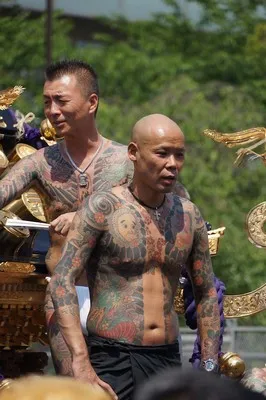Table of Contents
- The Cultural Context of Yakuza Tattoos
- Symbols and Meanings
- The Process and Ritual of Tattooing
- Identity Construction and Socialization
- Tattoos as a Stigma and Form of Resistance
- The Role of Tattoos in Group Cohesion
- Tattoos as a Form of Social Interaction
- Public Perception and Media Representation
- Tattoos as a Mechanism of Social Control
- Identity Negotiation in Different Social Settings
- Tattoos and the Changing Landscape of the Yakuza
- Conclusion
- Poll
- Think!
- Essay Suggestions
- Research Suggestions
- Further Reading
Symbolic Interactionism is a theoretical framework in sociology that focuses on the symbols and meanings individuals ascribe to objects, events, and behaviors within their social world. This micro-level theory emphasizes the subjective aspects of social life, examining how individuals create and interpret meanings through social interaction. Within this context, the tradition of Yakuza tattoos, or “irezumi,” offers a rich site for sociological analysis. These intricate and often full-body tattoos are not just artistic expressions but also carry deep symbolic significance within the Yakuza, the organized crime syndicates in Japan. By examining Yakuza tattoos through the lens of Symbolic Interactionism, we can gain insights into how these symbols function within the subculture, how they convey identity, and how they mediate social relationships.
The Cultural Context of Yakuza Tattoos
Yakuza tattoos are deeply embedded in the historical and cultural fabric of Japan. The tradition of irezumi dates back centuries and was initially associated with various social groups, including laborers and criminals. Over time, it became a distinctive feature of the Yakuza. These tattoos often cover large parts of the body and are replete with traditional Japanese motifs such as dragons, koi fish, and cherry blossoms, each symbolizing different virtues and narratives. The process of getting a Yakuza tattoo is lengthy, painful, and expensive, reflecting a significant personal investment and commitment to the group. In a society where tattoos are generally stigmatized and associated with criminality, Yakuza tattoos serve as powerful markers of identity and affiliation.
Symbols and Meanings
In Symbolic Interactionism, symbols are central to understanding how individuals and groups construct reality. Yakuza tattoos are laden with symbolic meanings that communicate various aspects of the wearer’s identity and status within the organization. For instance, the dragon, a common motif in Yakuza tattoos, symbolizes strength, courage, and wisdom. Koi fish, known for swimming upstream against strong currents, represent perseverance and determination. These symbols are not arbitrary; they are deeply embedded in Japanese mythology and cultural history, providing a rich tapestry of meanings that Yakuza members draw upon to construct their identities. The specific choice of tattoos and their placement on the body also convey messages about the individual’s role and rank within the organization, creating a complex language of symbols understood by insiders and outsiders alike.
Dragon Tattoos
The dragon is one of the most iconic and powerful symbols in Japanese tattoo art and holds significant meaning within the Yakuza. In Japanese culture, dragons are not seen as malevolent creatures as in some Western traditions, but as benevolent beings that bring wealth, wisdom, and strength. Yakuza members who choose dragon tattoos often see themselves as embodying these qualities. The dragon’s ability to control water and weather is a metaphor for the Yakuza’s influence and power within society. The color of the dragon also adds layers of meaning; for instance, a black dragon is often associated with experience and wisdom, reflecting the status of an elder or leader within the group.
Koi Fish Tattoos
Koi fish are another prevalent symbol in Yakuza tattoos, representing perseverance, courage, and ambition. According to Japanese legend, koi fish swim upstream against strong currents and, if they can overcome obstacles, they transform into dragons. This narrative of transformation and overcoming challenges resonates deeply with the Yakuza ethos of resilience and tenacity. Koi tattoos can vary in color, each hue carrying its own significance. A red koi represents love and bravery, while a blue koi stands for tranquility and calmness. The direction in which the koi is swimming also matters; an upstream koi symbolizes strength and the ability to overcome adversity, while a downstream koi indicates that the wearer has already achieved success.
Cherry Blossom Tattoos
Cherry blossoms, or sakura, are a symbol of the fleeting nature of life and beauty in Japanese culture. They bloom briefly in spring and then fall, which is often seen as a reminder of the transient nature of existence. For Yakuza members, cherry blossom tattoos can serve as a poignant reminder of the impermanence of life and the importance of living in the moment. This symbolism is particularly resonant given the often-dangerous lifestyle of the Yakuza, where death can be a constant presence. Additionally, cherry blossoms can signify renewal and new beginnings, reflecting personal growth and change within the individual’s life.
Tiger Tattoos
Tigers are revered in Japanese culture as protectors against evil spirits and bad luck. In the context of Yakuza tattoos, a tiger symbolizes strength, courage, and the ability to overcome adversity. The tiger is often depicted in dynamic, powerful poses, reinforcing its association with ferocity and dominance. For Yakuza members, a tiger tattoo can signify a guardian role within the organization, as well as a fierce, indomitable spirit. The tiger’s presence on the skin serves as a constant reminder of the wearer’s commitment to these qualities and their readiness to confront challenges head-on.
Snake Tattoos
Snakes hold a complex place in Japanese symbolism, often associated with both protection and danger. In Yakuza tattoos, snakes can symbolize wisdom, protection, and the cycle of life and death. They are frequently depicted alongside other symbols, such as peonies, which represent prosperity and good fortune. This combination can indicate a balance of power and benevolence, reflecting the Yakuza’s dual role as both protectors and enforcers within their communities. A snake wrapped around a sword or dagger, for instance, might symbolize the lethal yet controlled power of the wearer.
Phoenix Tattoos
The phoenix is a mythological bird that rises from its ashes, symbolizing rebirth, immortality, and renewal. In Yakuza tattoos, the phoenix represents transformation and triumph over adversity. This powerful symbol resonates with the narratives of personal growth and redemption that many Yakuza members embrace. A phoenix tattoo can signify a new beginning or a personal evolution, marking significant changes in the wearer’s life. The vibrant colors and intricate details of a phoenix tattoo also showcase the artistry and dedication involved in the tattooing process.
Demon Masks (Oni) Tattoos
Oni, or demon masks, are traditional symbols in Japanese folklore that represent malevolent spirits or demons. In the context of Yakuza tattoos, oni can symbolize protection from evil spirits, embodying the wearer’s defiance and strength against adversaries. These tattoos are often detailed and fierce, with exaggerated features that evoke fear and respect. An oni tattoo can also serve as a warning to others, symbolizing the wearer’s fearsome nature and readiness to confront danger. The duality of oni—both as protectors and harbingers of chaos—reflects the complex identity of Yakuza members who navigate between societal norms and the underworld.
Peony Tattoos
Peonies are frequently paired with other symbols in Yakuza tattoos, such as lions or dragons, to create a balance between strength and beauty. In Japanese culture, peonies symbolize wealth, good fortune, and honor. For Yakuza members, a peony tattoo can signify a desire for prosperity and success, as well as a commitment to living honorably according to their own code of ethics. The lush, vibrant appearance of peonies in tattoo art highlights the wearer’s appreciation for beauty and the finer things in life, even amidst the harsh realities of their existence.
Water and Waves Tattoos
Water and wave motifs are common elements in Yakuza tattoos, representing life’s constant motion and the flow of challenges and opportunities. Water can symbolize adaptability, resilience, and the ability to navigate difficult situations. In the context of Yakuza tattoos, waves often accompany other symbols, such as koi fish or dragons, enhancing their meanings. The depiction of turbulent waves can reflect the wearer’s readiness to face and overcome tumultuous times, while calmer waters may signify peace and tranquility achieved through perseverance and strength.
By examining these symbols in detail, we can appreciate the intricate language of Yakuza tattoos and the profound meanings they convey. These tattoos are not mere body art but a complex system of symbols that communicate identity, values, and social status within the Yakuza. Each tattoo is a personal and public declaration of the wearer’s beliefs, experiences, and aspirations, reflecting the deep cultural heritage and social dynamics of this unique subculture. Through their tattoos, Yakuza members engage in a continuous process of identity construction and negotiation, using these powerful symbols to navigate their social world.
The Process and Ritual of Tattooing
The process of acquiring a Yakuza tattoo is itself a significant ritual, laden with symbolic meaning. Unlike modern tattooing methods, traditional irezumi is done by hand, using wooden handles and metal needles. This method is not only more painful and time-consuming but also more prestigious, signifying the wearer’s endurance and commitment. The act of getting tattooed often involves a mentor-mentee relationship, where an experienced Yakuza member sponsors a novice, further embedding the individual into the social fabric of the group. The tattooing sessions can take years to complete, with each session reinforcing the individual’s identity and allegiance to the Yakuza. This ritualistic aspect underscores the importance of the tattoo as a symbol of belonging and loyalty.
Identity Construction and Socialization
Get the full article AD FREE. Join now for full access to all premium articles.
View Plans & Subscribe Already a member? Log in.
Poll
Think!
The purpose of the “Think!” box is to encourage deeper reflection on the article’s content and to engage readers with thought-provoking questions. It aims to enhance understanding by prompting critical thinking and personal insight.
What do you think tattoos can say about a person’s identity? For example, how do certain symbols or designs reflect someone’s values or beliefs?
How might a group like the Yakuza use tattoos to strengthen their sense of community? Think about how shared symbols can create bonds among members.
Why do you think tattoos are often associated with rebellion or non-conformity? Consider how society views tattoos and what they might represent.
In what ways do you believe tattoos can serve as a form of personal expression? For instance, how do people use tattoos to tell their own stories or mark significant life events?
How do you think cultural attitudes towards tattoos have changed over time? Reflect on how tattoos were perceived in the past versus how they are seen today.
Let us know your thoughts in the comments below.
Essay Suggestions
Our essay suggestions are a helpful resource for undergraduate students (or other students) looking for inspiration for their essays. Each question is directly relevant to the article content adding further insight and possibilities for students.
The Role of Symbolism in Yakuza Tattoos
Explore how different symbols in Yakuza tattoos convey meanings and messages about identity, status, and values within the organization and in broader Japanese society.
Tattoos as a Form of Social Control in the Yakuza
Examine how the process and display of Yakuza tattoos function to enforce group norms, maintain hierarchy, and regulate behavior within the criminal organization.
The Social Construction of Deviance: Yakuza Tattoos and Stigma
Analyze how Yakuza tattoos are perceived in mainstream Japanese society and how these perceptions contribute to the social construction of deviance and the marginalization of tattooed individuals.
Identity Negotiation and Yakuza Tattoos
Investigate how Yakuza members navigate their identities in different social contexts, balancing their affiliation with the Yakuza with other roles and societal expectations, through the use of their tattoos.
The Evolution of Yakuza Tattoos in Contemporary Japan
Discuss how changing social attitudes towards tattoos in Japan are influencing the styles, meanings, and prevalence of Yakuza tattoos, and what this evolution indicates about broader cultural shifts.
Research Suggestions
Our research suggestions are targeted towards postgraduate researchers and above who may be looking for inspiration in finding new research possibilities.
The Intergenerational Transmission of Yakuza Symbolism
Investigate how symbolic meanings in Yakuza tattoos are passed down and transformed across different generations within the organization, examining changes in design preferences and cultural interpretations.
Comparative Analysis of Tattoo Symbolism in Different Organized Crime Groups
Conduct a comparative study of how various organized crime groups around the world use tattoos as symbols of identity, power, and cohesion, with a focus on similarities and differences with Yakuza tattoos.
The Impact of Legal and Social Reforms on Yakuza Tattoo Practices
Explore how recent legal pressures and social reforms in Japan, aimed at curbing Yakuza activities, are affecting the tradition of tattooing within the group, including shifts in visibility and acceptance.
Media Representation and Public Perception of Yakuza Tattoos
Analyze the role of media in shaping public perceptions of Yakuza tattoos, considering how different forms of media portray these symbols and influence societal attitudes towards both the tattoos and their bearers.
Psychosocial Effects of Tattoo Stigmatization on Yakuza Members
Examine the psychological and social impacts of stigmatization associated with Yakuza tattoos on members’ mental health, social interactions, and identity formation, including coping mechanisms and resistance strategies.
Further Reading
Please note that some of these sources may be paywalled and some may be open access. We have no control over this. If they are paywalled, those who have access to an institution may be able to access them through their relevant resources department, library, or institutional access.
Atkinson, M. (2003). Tattooed: The Sociogenesis of a Body Art.
Bosmia, A. N., Griessenauer, C., & Tubbs, R. (2014). Yubitsume: ritualistic self-amputation of proximal digits among the Yakuza. Journal of Injury and Violence Research, 6, 54-56.
Cains, G. E., & Byard, R. (2009). The Forensic and Cultural Implications of Tattooing. [Journal], 197-220.
Hill, P. B. E. (2004). The Changing Face of the Yakuza. Global Crime, 6, 116-97.
Johnson, E. (1990). Yakuza (Criminal Gangs) in Japan: Characteristics and Management in Prison. Journal of Contemporary Criminal Justice, 6, 113-126.
Lane, D. (2014). Tat’s All Folks: An Analysis of Tattoo Literature. Sociology Compass, 8, 398-410.
Martin, C. (2013). Tattoos as Narratives: Skin and Self. [Journal], 4, 2-46.
Newsham, G. (2019). Japan’s Yakuza – still alive, and yes, they do matter. Journal of Financial Crime.
Roux, D., & Belk, R. (2018). The Body as (Another) Place: Producing Embodied Heterotopias Through Tattooing. Journal of Consumer Research.
Sanders, C. (1989). Customizing the Body: The Art and Culture of Tattooing.
Siniawer, E. (2012). Befitting Bedfellows: Yakuza and the State in Modern Japan. Journal of Social History, 45, 623-641.
Stylianoudi, L. (2020). Tattooing: Imprinting the Self. Punctum. International Journal of Semiotics.
Tsunenari, S., Idaka, T., Kanda, M., & Koga, Y. (1981). Self‐mutilation: Plastic spherules in penile skin in yakuza, Japan’s racketeers. The American Journal of Forensic Medicine and Pathology, 2, 203–208.
Tsunenari, S., Yonemitsu, K., Kanbe, T., & Kanda, M. (1984). How to identify the Yakuza, Japanese racketeers–their sociology, criminology and physical characteristics. Annals of the Academy of Medicine, Singapore, 13(1), 25-31.
[/membership]
Get the full article AD FREE. Join now for full access to all premium articles.
View Plans & Subscribe Already a member? Log in.





